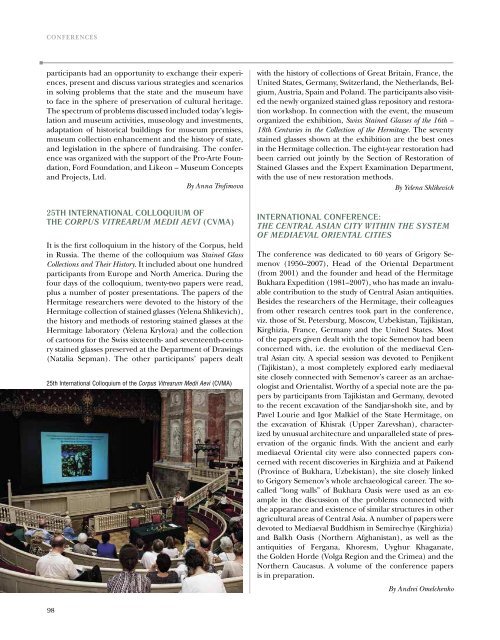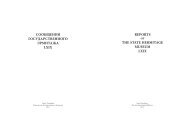The STaTe hermiTage muSeum annual reporT
The STaTe hermiTage muSeum annual reporT
The STaTe hermiTage muSeum annual reporT
You also want an ePaper? Increase the reach of your titles
YUMPU automatically turns print PDFs into web optimized ePapers that Google loves.
conferences<br />
participants had an opportunity to exchange their experiences,<br />
present and discuss various strategies and scenarios<br />
in solving problems that the state and the museum have<br />
to face in the sphere of preservation of cultural heritage.<br />
<strong>The</strong> spectrum of problems discussed included today’s legislation<br />
and museum activities, museology and investments,<br />
adaptation of historical buildings for museum premises,<br />
museum collection enhancement and the history of state,<br />
and legislation in the sphere of fundraising. <strong>The</strong> conference<br />
was organized with the support of the Pro-Arte Foundation,<br />
Ford Foundation, and Likeon – Museum Concepts<br />
and Projects, Ltd.<br />
By Anna Trofimova<br />
25Th inTernaTional colloQuium of<br />
<strong>The</strong> coRpus viTReaRum medii aevi (cvma)<br />
It is the first colloquium in the history of the Corpus, held<br />
in Russia. <strong>The</strong> theme of the colloquium was Stained Glass<br />
Collections and <strong>The</strong>ir History. It included about one hundred<br />
participants from Europe and North America. During the<br />
four days of the colloquium, twenty-two papers were read,<br />
plus a number of poster presentations. <strong>The</strong> papers of the<br />
Hermitage researchers were devoted to the history of the<br />
Hermitage collection of stained glasses (Yelena Shlikevich),<br />
the history and methods of restoring stained glasses at the<br />
Hermitage laboratory (Yelena Krylova) and the collection<br />
of cartoons for the Swiss sixteenth- and seventeenth-century<br />
stained glasses preserved at the Department of Drawings<br />
(Natalia Sepman). <strong>The</strong> other participants’ papers dealt<br />
25th International Colloquium of the Corpus Vitrearum Medii Aevi (CVMA)<br />
with the history of collections of Great Britain, France, the<br />
United States, Germany, Switzerland, the Netherlands, Belgium,<br />
Austria, Spain and Poland. <strong>The</strong> participants also visited<br />
the newly organized stained glass repository and restoration<br />
workshop. In connection with the event, the museum<br />
organized the exhibition, Swiss Stained Glasses of the 16th –<br />
18th Centuries in the Collection of the Hermitage. <strong>The</strong> seventy<br />
stained glasses shown at the exhibition are the best ones<br />
in the Hermitage collection. <strong>The</strong> eight-year restoration had<br />
been carried out jointly by the Section of Restoration of<br />
Stained Glasses and the Expert Examination Department,<br />
with the use of new restoration methods.<br />
By Yelena Shlikevich<br />
inTernaTional conference:<br />
<strong>The</strong> cenTRal asian ciTY wiThin <strong>The</strong> sYsTem<br />
of mediaeval oRienTal ciTies<br />
<strong>The</strong> conference was dedicated to 60 years of Grigory Semenov<br />
(1950–2007), Head of the Oriental Department<br />
(from 2001) and the founder and head of the Hermitage<br />
Bukhara Expedition (1981–2007), who has made an invaluable<br />
contribution to the study of Central Asian antiquities.<br />
Besides the researchers of the Hermitage, their colleagues<br />
from other research centres took part in the conference,<br />
viz. those of St. Petersburg, Moscow, Uzbekistan, Tajikistan,<br />
Kirghizia, France, Germany and the United States. Most<br />
of the papers given dealt with the topic Semenov had been<br />
concerned with, i.e. the evolution of the mediaeval Central<br />
Asian city. A special session was devoted to Penjikent<br />
(Tajikistan), a most completely explored early mediaeval<br />
site closely connected with Semenov’s career as an archaeologist<br />
and Orientalist. Worthy of a special note are the papers<br />
by participants from Tajikistan and Germany, devoted<br />
to the recent excavation of the Sandjar-shokh site, and by<br />
Pavel Lourie and Igor Malkiel of the State Hermitage, on<br />
the excavation of Khisrak (Upper Zarevshan), characterized<br />
by unusual architecture and unparalleled state of preservation<br />
of the organic finds. With the ancient and early<br />
mediaeval Oriental city were also connected papers concerned<br />
with recent discoveries in Kirghizia and at Paikend<br />
(Province of Bukhara, Uzbekistan), the site closely linked<br />
to Grigory Semenov’s whole archaeological career. <strong>The</strong> socalled<br />
“long walls” of Bukhara Oasis were used as an example<br />
in the discussion of the problems connected with<br />
the appearance and existence of similar structures in other<br />
agricultural areas of Central Asia. A number of papers were<br />
devoted to Mediaeval Buddhism in Semirechye (Kirghizia)<br />
and Balkh Oasis (Northern Afghanistan), as well as the<br />
antiquities of Fergana, Khoresm, Uyghur Khaganate,<br />
the Golden Horde (Volga Region and the Crimea) and the<br />
Northern Caucasus. A volume of the conference papers<br />
is in preparation.<br />
By Andrei Omelchenko<br />
conferences<br />
conference devoTed To 30 yearS<br />
of <strong>The</strong> heraldic Seminar<br />
It is, largely, due to close connection of heraldry and the<br />
history of culture that the Hermitage has traditionally been<br />
a repository of heraldic knowledge and centre of heraldry<br />
research. In the 19th century, outstanding heraldry experts,<br />
such as Florian Gilles and Baron Boris von Koehne,<br />
worked in the Hermitage. <strong>The</strong> curator of the Jewellery<br />
Gallery, Arminius von Voelkersahm and the curator of the<br />
arms collection, Eduard Lenz were experts in methods of<br />
heraldic analysis as well. In the early 20th century, among<br />
the Hermitage curators was a renowned Russian heraldist<br />
Sergei Troinitsky. During the Soviet period, the traditions<br />
of heraldic studies in the Hermitage, with its richest<br />
collections and the library, were maintained by the elder<br />
generation of curators, such as Alexander Voitov (Russian<br />
heraldry), Andrei Korsun (general and Western European<br />
heraldry), Lev Rakov and Vladislav Glinka (Russian uniforms).<br />
<strong>The</strong> outstanding numismatist Ivan Spassky was also<br />
a historian of awards; Nikolai Semenovich was concerned<br />
with the study of standards and banners. This tradition was<br />
continued later on, the logical result of it having been the<br />
organization, in 1980, of the seminar “Heraldry, an Auxiliary<br />
Historical Discipline”. On 15–16 December 2010<br />
a meeting dedicated to 30 years of the Hermitage Heraldic<br />
Seminar was held in the State Council Room of the State<br />
Hermitage, with the participation of representatives of the<br />
Hermitage, the State Russian Museum, the Heraldic Council<br />
under the President of the Russian Federation, the Institute<br />
of Material Culture (Russian Academy of Sciences),<br />
Historical and Archival Institute (Moscow) and Institute<br />
of World History (Russian Academy of Sciences), as well<br />
as researchers from Kirov, Ryazan, Yekaterinburg, Tver<br />
and Krasnodar. A very significant role in the organization<br />
of the meeting belongs to the leading expert on the history<br />
of uniforms, head of the Military Heraldry Division of the<br />
Hermitage Arsenal, Sergei Plotnikov, who died on 14 February<br />
2011. Those who knew him and worked with him will<br />
always miss a good friend and an outstanding scholar and<br />
museologist worthy of the museum, which he represented<br />
with dignity.<br />
<strong>The</strong> range and scope of the papers given has demonstrated<br />
close ties of the Hermitage Heraldic Seminar’s thirty<br />
years’ activity with various directions in Russian heraldry,<br />
both theoretical and applied.<br />
By Georgy Vilinbakhov<br />
diSSerTaTionS<br />
98 99<br />
inga yakovleva<br />
chineSe porcelain of <strong>The</strong> laTe Qing<br />
period (1796–1911). arTiSTic TradiTionS<br />
and <strong>The</strong>ir culTural conTexT<br />
For the Degree of Kandidat (Candidate) of Art History<br />
<strong>The</strong> object of the study is Chinese porcelain of the Late<br />
Qing Period (1796–1911), which has not been duly dealt<br />
with in scholarly publications so far. For this reason, the<br />
theme is a considerable lacuna in the study of Chinese<br />
pottery. <strong>The</strong> dissertation is a multi-aspect study of Late<br />
Qing porcelain production, including criteria to discern<br />
authentic works from fakes. <strong>The</strong> significance of the problem<br />
of porcelain authenticity for the period in question<br />
is connected with the fact that certain categories of works<br />
were created as part of a retrospective trend concerned<br />
with making replicas of earlier productions and aging<br />
techniques.<br />
<strong>The</strong> features of novelty of the present work include the<br />
description of Chinese porcelain art in 1796–1911 as a historical<br />
and cultural phenomenon, as well as a study of its<br />
nineteenth-century milieu. A new periodization of Chinese<br />
porcelain making in the 19th century has been suggested,<br />
which reflects the major stages in its stylistic evolution. Besides,<br />
the dissertation contains a differential classification<br />
system of porcelain productions and principles of characterization<br />
of individual works. <strong>The</strong> dissertation includes<br />
translations from European and Chinese sources, fundamental<br />
for the field in question, which contain data unreflected<br />
in Russian publications.<br />
<strong>The</strong> reconstruction of the general panorama of the development<br />
of Chinese porcelain in the 19th century given in<br />
the dissertation, as well as the description of the methods<br />
and techniques used by porcelain makers can be the basis<br />
for future studies in the present area.




